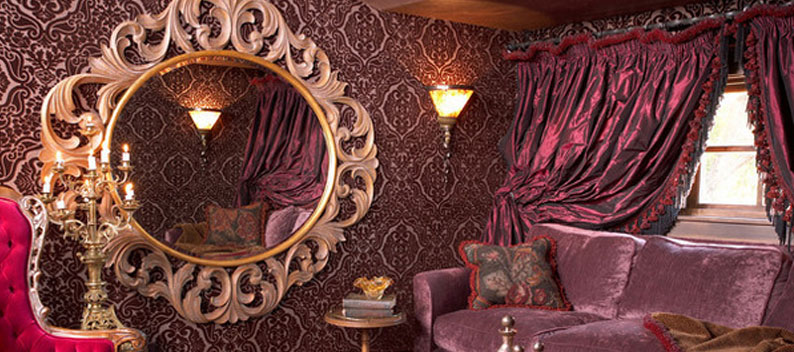Part Five: Victorian
In the early Victorian period, curtains had finally become a fixture of middle and even working class homes. Thanks to the industrial revolution, including engraved roller printing which was so much faster than block printing, attractive and inexpensive fabrics meant a vast number of materials and styles to choose from and which would fit almost any budget. While the wealthy still preferred velvet, silk and lush brocade, the proliferation of printed cotton in particular made curtains not only available but an essential feature for any respectable home. However styles were still unsettled and mix of Gothic and “neo-Rococo” was not uncommon.
Another major change was the invention of synthetic dyes. Most dyes of the past had been made from natural materials, but these were difficult to extract, expensive and often inconsistent in hue. The first aniline dye, mauve, was introduced in by Henry Perkin in 1856 and other synthetics were to appear as the century progressed, making it a ‘high tech’ industry of the time, and including colours such as magenta, violet and green brilliant red dye alizarin. It is no doubt for this reason the Victorian period is associated gaudy colour schemes as well as an excess of ornament, and why the Arts and Crafts Movement of William Morris reacted so intensely against it.
Layering blinds and curtains
Most Victorian windows had three layers of light protection, consisting of a cornice, a drapery or valance, and one or more curtains. Blinds were essential, controlled by “rack pulleys” which stopped the tape or cord from unrolling by means of a small piece of hardware attached to the side of the window frame. Generally made of canvas-like Holland linen (a type of canvas), blinds were usually dark, trimmed with fringes sometimes painted with a rural scene.
In the mid 19th century, the boxed wood cornice covered the curtain rings or rope pulleys and was also intended to keep drafts away at the top of the window. Curtains were held either a gilded or painted pole or else a slim panel screwed to the moulding at the top of the window, and the drapery or valance below it, attached by tacks, hooks or rings. Since blinds were expected to do the job of keeping out the light, curtains were more intended to keep out drafts. Narrow and long, without a pinch pleat in sight, they were meant to puddle on the floor when closed and just touch the floor when looped back. While the French rod was used by the wealthy, most ordinary people could not afford them and thus most were drawn by hand.
Drapery – decoration or dirt trap? Curtains enter the age of industrialisation
With the growing filth of industrialized Britain and its increasing coal smoke, some critics in Victorian times cited curtains and draperies, especially swags or festoons as dirt traps and recommended against them, but to little avail. Victorians adored their heavy living room drapery, the more layers the better to keep out chill and create a cosy interior. White lace, silk or muslin under curtains, often fringed at the edge or having a contrasting border such as dark green or yellow, could after all be easily washed and its visible cleanliness was of primary importance. Moreover the growing obsession with propriety meant privacy, and the exclusion of the increasing hoards of people as well as crime from the sanctity of the family and its possessions.
Return in two weeks for Part Six: Art Nouveau




